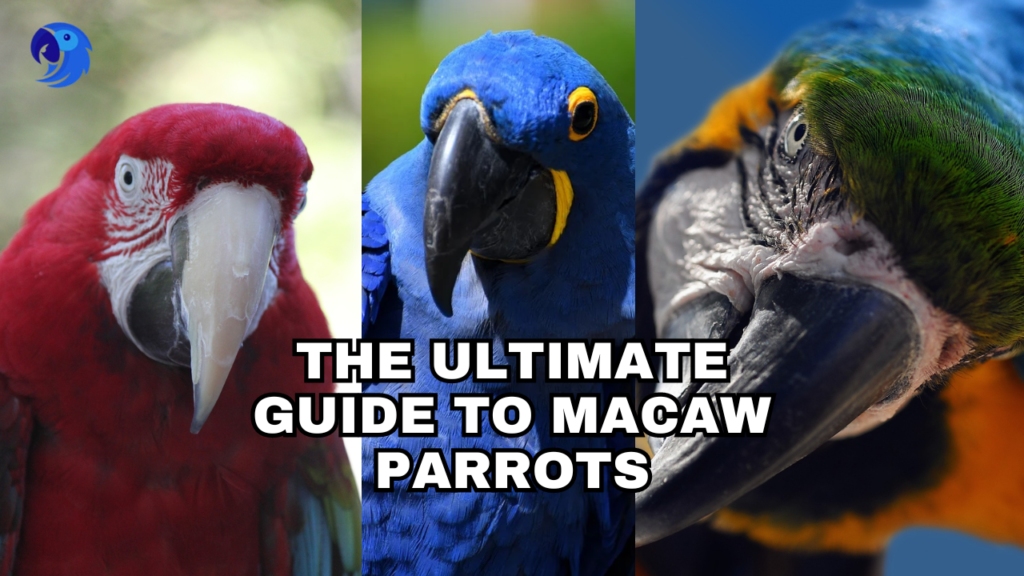Introduction to Macaw Parrots
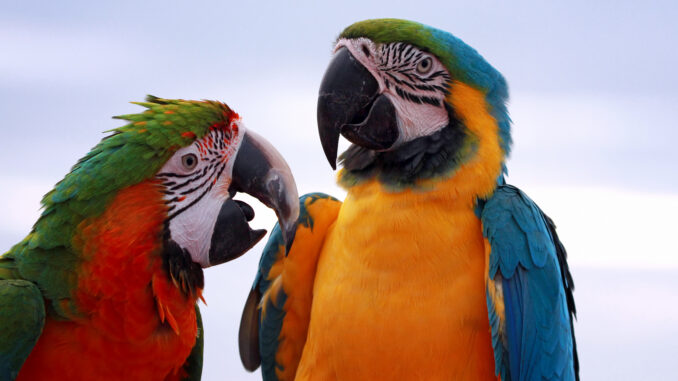
1.1. What are macaw parrots?
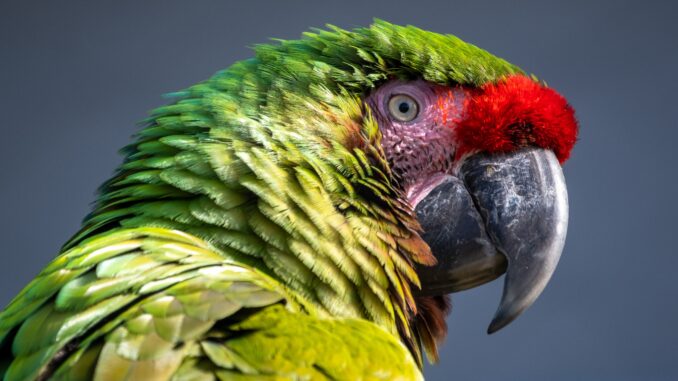
Macaw parrots are some of the most colorful and charismatic birds you’ll ever meet! These large, beautiful parrots are known for their vibrant feathers, curved beaks, and long tails. They’re part of the parrot family and are considered among the most intelligent birds in the world.
I remember the first time I saw a macaw up close at a bird sanctuary. I was amazed by its size and the way it seemed to look right through me with those clever eyes. It’s no wonder these birds have captured the hearts of so many people!
1.2. Natural habitat and distribution
Macaws are native to the rainforests and woodlands of Central and South America. They love warm, humid climates and can be found in countries like Brazil, Peru, and Mexico. In the wild, they spend most of their time high up in the forest canopy, where they feed, socialize, and nest.
It’s sad to think that many macaw species are endangered due to habitat loss and illegal trapping for the pet trade. That’s why it’s so important for us to learn about these amazing birds and do what we can to protect them.
1.3. Macaw characteristics and behavior
Macaws are known for their playful and social nature. They’re incredibly smart and can even learn to mimic human speech! These birds are also very active and need plenty of space to fly, climb, and play.
One thing that always makes me smile is how affectionate macaws can be. They form strong bonds with their owners and other macaws. Many macaw species mate for life, which I think is pretty romantic!
2. Macaw Species and Their Unique Traits
2.1. Blue and Gold Macaw
The Blue and Gold Macaw is probably one of the most recognizable macaw species. As the name suggests, they have beautiful blue feathers on their back and wings, with golden-yellow feathers on their chest and belly. These big birds can grow up to 3 feet long from beak to tail tip!
I once met a Blue and Gold Macaw named Charlie at a friend’s house. He was such a character, always bobbing his head to music and trying to join our conversations. It’s easy to see why these birds are so popular as pets.
2.2. Scarlet Macaw
Scarlet Macaws are like flying rainbows! They have bright red feathers covering most of their body, with splashes of yellow and blue on their wings. These birds are slightly smaller than Blue and Gold Macaws but are just as full of personality.
I’ve always been in awe of Scarlet Macaws. Their vivid colors seem almost too beautiful to be real. It’s no wonder they’re often featured in movies and TV shows about tropical paradises.
2.3. Other popular macaw species
Several other macaw species are popular as pets or admired in the wild. Some of these include:
- Green-winged Macaw: Similar to the Scarlet Macaw but with green wings instead of yellow and blue.
- Hyacinth Macaw: The largest of all parrots, with stunning cobalt blue feathers.
- Military Macaw: Mostly green with a red forehead and blue wing tips.
- Severe Macaw: Smaller than many other macaws, with green feathers and a reddish-brown forehead.
Each of these species has its unique traits and quirks. It’s fascinating to learn about the differences between them!
3. Essential Macaw Care Guide
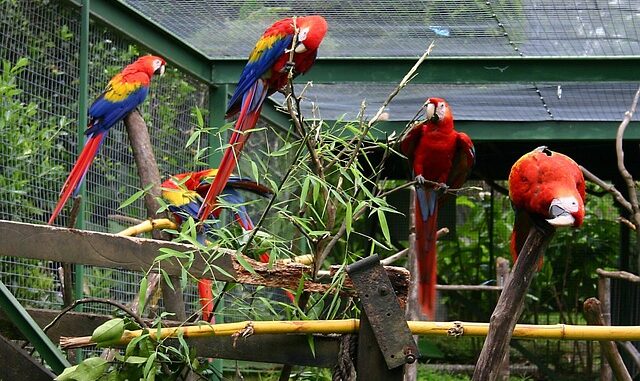
3.1. Dietary requirements and nutrition
Feeding a macaw is more complex than you might think! In the wild, these birds eat a variety of fruits, nuts, seeds, and vegetation. As pets, they need a balanced diet that mimics their natural eating habits.
A good macaw diet should include:
- High-quality pellets formulated for large parrots
- Fresh fruits and vegetables (like apples, berries, carrots, and leafy greens)
- Some nuts and seeds (in moderation)
- Occasional treats like cooked eggs or small amounts of lean meat
I always make sure to avoid giving my macaw friends foods that are toxic to birds, like avocado, chocolate, or caffeine. It’s also important to provide fresh, clean water daily.
3.2. Housing and cage setup
Macaws need a lot of space to be happy and healthy. A good rule of thumb is that the cage should be at least twice as wide as the bird’s wingspan and three times as tall as the bird from head to tail. For most macaws, this means a cage that’s at least 3 feet wide, 2 feet deep, and 5 feet tall – but bigger is always better!
The cage should be made of strong, bird-safe materials and have horizontal bars for climbing. Include several perches of different diameters to keep their feet healthy. Don’t forget to add plenty of toys for mental stimulation!
I like to think of setting up a macaw’s cage as creating a little bird paradise. The more fun and engaging you can make it, the happier your feathered friend will be.
3.3. Exercise and enrichment needs
Macaws are active birds that need plenty of exercise and mental stimulation. In the wild, they would spend hours flying, foraging, and socializing. As pets, we need to provide opportunities for them to stay active and engaged.
Some great ways to keep your macaw entertained include:
- Regular out-of-cage time for flying and exploring
- Puzzle toys that challenge their problem-solving skills
- Foraging toys that encourage natural behaviors
- Climbing structures and ropes
- Interaction and playtime with their human family
I’ve found that rotating toys regularly helps keep things interesting for macaws. They’re so smart that they can get bored easily if their environment stays the same all the time.
4. Macaw Health and Longevity
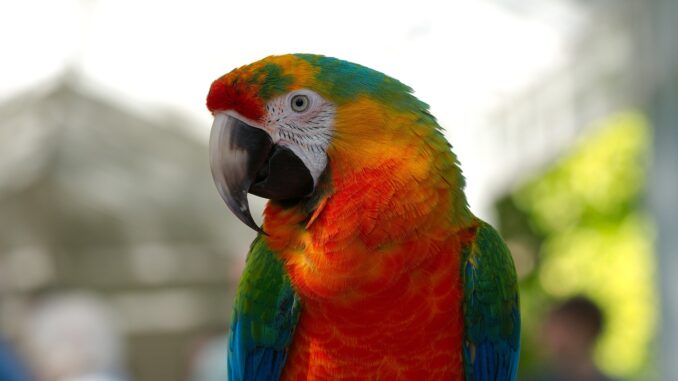
4.1. Common health issues and prevention
Like all pets, macaws can face certain health issues. Some common problems include:
- Feather picking due to stress or boredom
- Respiratory infections
- Beak and nail overgrowth
- Vitamin A deficiency
- Psittacosis (a bacterial infection)
Many of these issues can be prevented with proper diet, hygiene, and regular vet check-ups. I always keep an eye on my macaw friends for any changes in behavior, appetite, or droppings, as these can be early signs of health problems.
4.2. Lifespan in captivity vs. wild
One of the amazing things about macaws is how long they can live! In the wild, macaws typically live for 30-50 years. In captivity, with good care, they can live even longer – some have been known to reach 60 or even 70 years old!
This long lifespan is both a blessing and a responsibility. It’s wonderful to have a companion for so many years, but it also means that getting a macaw is a lifetime commitment. I always make sure people understand this before they consider getting a macaw as a pet.
4.3. Regular veterinary care and check-ups
Regular vet visits are crucial for keeping your macaw healthy. I recommend finding an avian veterinarian – they specialize in bird care and will be best equipped to handle your macaw’s needs.
Typically, adult macaws should have a check-up once a year. These visits usually include:
- Physical examination
- Weighing
- Beak and nail trimming if needed
- Blood tests to check for any health issues
Young macaws, older birds, or those with health problems may need more frequent visits. It’s always better to catch any issues early!
5. Training and Socialization
5.1. Basic training techniques
Training a macaw can be a fun and rewarding experience. These intelligent birds are capable of learning many commands and tricks. The key is to use positive reinforcement – rewarding good behavior with treats, praise, or attention.
Some basic commands to start with include:
- “Step up” (to get them to step onto your hand)
- “Down” (to get them to step off)
- “No” (to discourage unwanted behavior)
Remember to keep training sessions short and fun. Macaws have the attention span of a toddler, so 5-10 minute sessions a few times a day work best.
5.2. Teaching macaws to talk
Many macaw species are excellent talkers, though some are better than others. The key to teaching a macaw to talk is repetition and patience. Start with simple words or phrases and repeat them often in context.
For example, you might say “Hello” every time you approach the cage, or “Good morning” when you uncover the cage in the morning. Some macaws pick up words quickly, while others may take months or even years to start talking.
I once knew a macaw who could say “I love you” clear as day. It was heart-melting!
5.3. Addressing behavioral issues
Like any intelligent animal, macaws can develop behavioral issues if their needs aren’t met. Common problems include:
- Screaming or excessive noise
- Biting
- Feather plucking
- Aggression
Most of these issues stem from boredom, lack of socialization, or stress. The best approach is usually to identify and address the root cause. This might mean providing more toys, increasing out-of-cage time, or adjusting their diet.
I’ve found that consistency is key when dealing with behavioral issues. All family members need to be on the same page about how to respond to unwanted behaviors.
6. The Cost of Owning a Macaw
6.1. Initial purchase price
Macaws are not cheap pets. The initial cost can range from $1,000 to $18,000 or more, depending on the species and whether you’re buying from a breeder or adopting from a rescue.
Here’s a rough price range for some popular macaw species:
- Blue and Gold Macaw: $1,000 – $3,000
- Scarlet Macaw: $2,000 – $4,000
- Hyacinth Macaw: $8,000 – $18,000+
Remember, the initial purchase price is just the beginning of the costs associated with owning a macaw.
6.2. Ongoing care expenses
The ongoing costs of caring for a macaw can add up quickly. Some regular expenses include:
- Food: High-quality pellets, fresh fruits and vegetables, and occasional treats
- Toys: Macaws need a variety of toys that will need to be replaced regularly
- Veterinary care: Annual check-ups and any unexpected health issues
- Cage and perches: These may need to be replaced or upgraded over time
I estimate that the monthly cost of caring for a macaw can range from $100 to $250, not including unexpected expenses.
6.3. Additional costs to consider
There are also some additional costs that potential macaw owners should keep in mind:
- Bird-proofing your home
- Travel carriers for vet visits
- Potential property damage (macaws can be destructive!)
- Pet insurance
- Boarding costs if you travel
It’s also worth considering the long-term financial commitment. Remember, macaws can live for 50+ years, so you’re looking at decades of expenses.
7. Adopting vs. Buying a Macaw
7.1. Benefits of macaw rescue and adoption
Adopting a macaw from a rescue organization can be a wonderful option. Some benefits include:
- Lower cost compared to buying from a breeder
- Giving a home to a bird in need
- Often, rescues provide thorough health checks and some training
- You may get an older bird with an established personality
I’ve known several people who’ve adopted macaws, and they’ve all found it to be an incredibly rewarding experience.
7.2. Finding reputable breeders and sellers
If you decide to buy a macaw, it’s crucial to find a reputable breeder. Look for someone who:
- Allows you to visit their facility
- Provides health certificates and genetic testing results
- Ask you questions about your ability to care for a macaw
- Offers ongoing support after the sale
Avoid pet stores or online sellers who can’t provide detailed information about the bird’s history and health.
7.3. Preparing your home for a new macaw
Before bringing a macaw home, you’ll need to do some preparation:
- Set up a spacious cage in a quiet area of your home
- Bird-proof the room where the cage will be located
- Purchase necessary supplies (food, toys, perches)
- Find an avian veterinarian in your area
- Educate all family members on macaw care and handling
I always recommend spending some time around macaws before committing to ownership. They’re wonderful birds, but they’re not for everyone!
8. Macaw Intelligence and Cognitive Abilities
8.1. Problem-solving skills
Macaws are incredibly intelligent birds with impressive problem-solving abilities. In the wild, they use tools to crack open nuts and navigate complex social structures. As pets, they can learn to solve puzzles, open cage latches, and even figure out how to get treats out of tricky toys.
I once watched a macaw solve a complex puzzle toy faster than I could! It was amazing to see how quickly she figured out the sequence of steps needed to reach the treat inside.
8.2. Emotional intelligence
Macaws are known for their emotional intelligence. They can form strong bonds with their owners and other birds, and they’re capable of expressing a range of emotions. They can show affection, jealousy, and happiness, and even seem to grieve when they lose a companion.
It’s important to remember that this emotional capacity means macaws need a lot of social interaction and emotional support. They’re not the kind of pet you can just leave in a cage all day.
8.3. Memory and Learning Capacity
Macaws have excellent memories and a great learning capacity. They can remember words, and routines, and even recognize specific people for years. This memory, combined with their problem-solving skills, means they’re always learning and adapting to their environment.
In my experience, macaws never stop surprising you with what they can learn and remember. It’s one of the things that makes them such fascinating companions.
9. Creating an Ideal Macaw Habitat
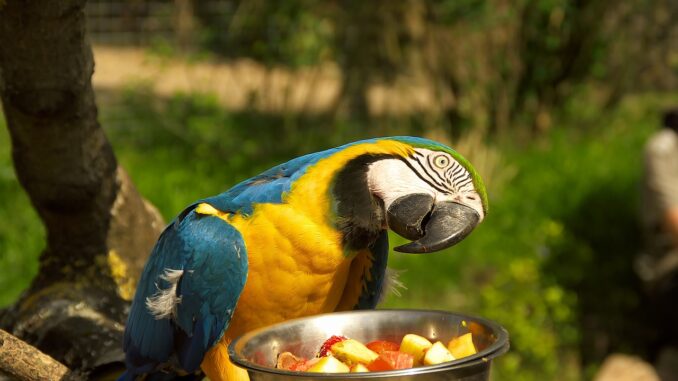
9.1. Indoor living spaces
When creating an indoor living space for a macaw, consider the following:
- A large cage or aviary with plenty of room to move and fly
- Multiple perches of different materials and diameters
- A variety of toys for mental stimulation
- Food and water dishes that are easy to access and clean
- A play stand or tree for out-of-cage time
Remember to place the cage in a room where the macaw can be part of family activities, but also have quiet time when needed.
9.2. Outdoor aviaries
If you have the space, an outdoor aviary can be a wonderful addition to your macaw’s habitat. It allows them to experience natural sunlight and fresh air. When creating an outdoor aviary:
- Ensure it’s secure from predators and escape-proof
- Provide shelter from rain and direct sunlight
- Include a variety of perches and swings
- Add natural branches for chewing and climbing
Always supervise your macaws when they’re outdoors, even in a secure aviary.
9.3. Environmental enrichment
Environmental enrichment is crucial for keeping macaws mentally and physically healthy. Some ideas include:
- Rotating toys regularly to keep things interesting
- Providing foraging opportunities (hiding treats in toys or around the cage)
- Offering a variety of textures and materials to explore
- Using background sounds like rainforest noises or gentle music
- Allowing supervised exploration of different rooms in your house
The goal is to create an environment that keeps your macaw engaged and stimulated, mimicking the variety they would experience in the wild.
10. Macaw Breeding and Reproduction
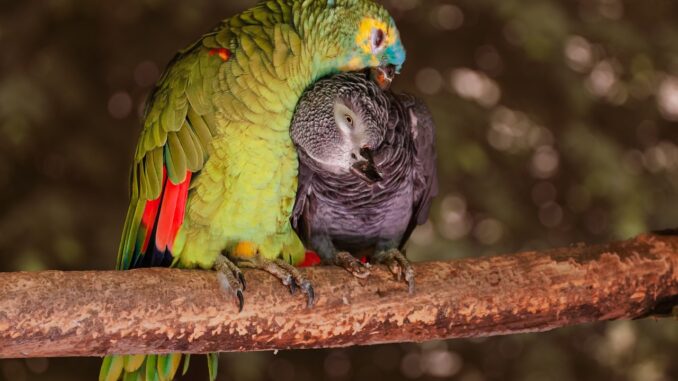
10.1. Mating behaviors
In the wild, macaws are monogamous and often mate for life. Their mating behaviors include mutual preening, feeding each other, and synchronized flying. As pets, macaws may display these behaviors towards their human companions or other birds in the household.
It’s important to note that breeding macaws in captivity should only be done by experienced professionals. It’s a complex process that requires a lot of knowledge and resources.
10.2. Nesting requirements
In nature, macaws nest in large tree cavities. If you’re considering breeding macaws (which, again, should only be done by professionals), you’ll need to provide a suitable nesting box. This should be large, secure, and placed in a quiet area.
The nesting period is a sensitive time for macaws. They can become more territorial and aggressive, even towards their usual caretakers.
10.3. Caring for macaw chicks
Caring for macaw chicks is a full-time job. In the wild, both parents share the responsibility of feeding and caring for the chicks. In captivity, chicks often need to be hand-fed every few hours around the clock.
Macaw chicks are born featherless and with their eyes closed. They develop quickly over the first few months, requiring careful monitoring of their diet, weight, and overall health.
11. Summary
Macaws are incredible birds that make fascinating pets for the right person. They’re intelligent, beautiful, and capable of forming strong bonds with their human families. However, they also require a significant time, space, and resources commitment.
If you’re considering a mac

